High Peaks Pure Earth has translated a blogpost by Woeser written on April 23, 2012 for the Tibetan service of Radio Free Asia and posted on her blog on May 18, 2012.
Woeser’s post describes the Chinese government’s attempt to control information and news, both in Tibet and Xinjiang, and the huge investment it has made to this end. Follow this link to read a New York Times article about information, technology and Tibet, that also mentions Labrang in Amdo.
Finally, follow these links to read more about the imaginative policies directed at monasteries such as the “Nine Haves” and “Six Ones”.
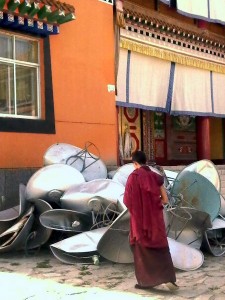
The photo was taken on May 20, 2009 in the old and famous Buddhist monastery, Chanding Monastery in Choné County, Kanlho Tibetan Autonomous Prefecture, Gansu Province. In order to prevent Tibetan monks and ordinary people from listening to or watching foreign radio or TV programmes, the local authorities make sure that all ground satellite dishes are being collected and destroyed.
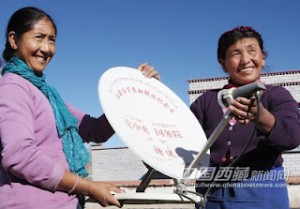
This photo comes from the “Exhibition Marking the 60th Anniversary of the Peaceful Liberation of Tibet”. The illustration’s caption reads: “The ‘Tibet-Xinjiang Project’, the project designed to ‘extend radio and TV coverage to every village’ is being implemented with great energy, the population with access to radio and TV has reached 90.28% and 91.41% respectively. The photo shows rural herds people in Taktsé County, testing their satellite receiver.”
“The Tibet-Xinjiang Project”: “Suppressing the
Voices of the Enemy”
By Woeser
As early as in 2000, the Chinese head of State at the time, Jiang Zemin, expressed the need “to suppress the voices of the enemy and propagate the voice of the Party and the nation among innumerable families and households”; subsequently, the local authorities implemented a large-scale radio and TV project – “The Tibet-Xinjiang Project” – particularly directed at the autonomous regions of Tibet, Xinjiang, Inner Mongolia, and Ningxia as well as other Tibetan regions and some “ethnic minority areas”. By 2010, the government had already invested an overall amount of 19,48 billion Yuan, a sum that has since been increasing every year.
“The Tibet-Xinjiang Project” has been propagated by the local authorities as a “welfare project” and as “benefiting the people” but in actual fact, even though related searches on the internet show various different meetings at which it was repeatedly stressed that “the Tibet-Xinjiang Project” is “of the utmost importance, most urgent and a political task possessing the most practical significance”, some officials are more direct and simply call it a “political project”.
The crucial goal of this “political project” is to obstruct international media by deploying high-power transmitters everywhere. For example, in order to prevent people from listening or watching international radio and TV programmes that report on Tibet such as Radio Free Asia or Voice Of America, in the whole of Tibet, almost 1000 interference stations were especially set up in an attempt to construct a virtual iron wall in the air that is tremendously difficult to break through.
After the protests that erupted across the whole of Tibet in 2008, the local authorities instigated a whole variety of blockades and oppression, including the confiscation and destruction of ground satellite receivers in monasteries as well as private homes. This is because satellite dishes deliver “the voices of the enemy”. For example, between April and May 2009, the local authorities of Labrang informed the monastery management committee, requesting them to order all monks who installed a satellite dish to remove their ground satellite receivers or else, if during inspections any remaining satellites were to be found, there would be a serious fine or other strict measures of punishment. Simultaneously, the Sangchu County Radio and Television Office sent people to the monks’ residences to install cable TV.
In March 2009, the local authorities ordered to have a special ground satellite receiver tailor-made just for Tibet; as a gift for “Serf Emancipation Day” it was distributed to Tibetan families in cities, villages and pastoral areas, resulting in them only being able to receive the “voice of the Party and the nation”.
In 2011, the government of the Tibet Autonomous Region declared that all monasteries in Tibet were to implement the “Nine Haves”, namely that monasteries not only have to possess portraits of the four national leaders and the flag of the PRC but also a radio and a TV set and newspapers. Of course, all of these have to only include official radio and TV programmes as well as the Party newspapers, “People’s Daily” and “Tibet Daily”. This means that the Party is using peremptory methods to force Tibetan nuns and monks to accept the broadcasting of “the voice of the Party and the nation”.
Recently, according to “Tibet Daily” and other official media, many Tibetan monasteries have already implemented the “Nine Haves”. There are also photos taken by journalists from official media that show monks and nuns either reading the Party’s newspapers or holding up the “leaders’ portraits”, displaying a smile that looks more ugly than someone crying.
Furthermore, the secretary of the Tibet Autonomous Region Party Committee, Chen Quanguo, specifically emphasised “The Tibet-Xinjiang Project” at a meeting in February this year, pointing out the need “to display the advantages of implementing the usage of one’s real identity to register for internet and mobile phone services, to improve the supervision of internet news, to build an air, ground and online control system that is impossible to permeate, and to make sure that in the whole of the vast territory covering an area of 1.2 million square metres, the voice of the Party’s Central Committee is always heard, always seen and that the voices of hostile powers and the Dalai Clique are never heard and never seen, thus guaranteeing ideological and cultural security.” What this means is that they want to trap Tibetans in an inescapable net.
His Holiness the Dalai Lama has stressed the importance of truth many times, which always relies on the freedom of information. However, just as His Holiness said, “Unfortunately, in some places in this world, news is commonly censored and distorted” and “severe censorship is immoral”. Authoritarian regimes that try to monopolise the truth, always devise every possible means to control news and to cover up the truth. In the fight for freedom of information, only the voice of the international media, symbolising “the tool of democracy”, are an important channel of truth and information. Even though the interference of “The Tibet-Xinjiang Project” is immense, even though the “Nine Haves” have already been “presented” to monasteries and households in Tibet, they are unlikely to destroy the thirst for facts and the wish and power to spread the truth.
April 23, 2012
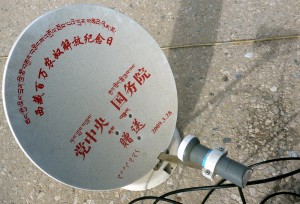
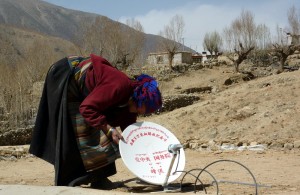
The ground satellite receivers shown in these two photos are one of many schemes that are part of “The Tibet-Xinjiang Project”. After the protests that erupted across the whole of Tibet in March 2008, they were tailor-made just for Tibet and can only receive the “voice of the Party and the country”; they served as gifts for “Serf Emancipation Day” and were distributed among Tibetan families in cities, villages and pastoral areas. The photo above was taken on a rooftop of a building in the old town of Lhasa, the photo below was taken on the rooftop of a rural household in Shigatse Prefecture. (Photos by Woeser).

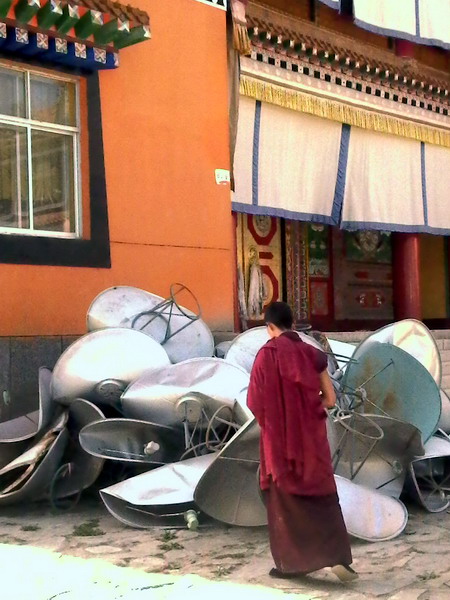

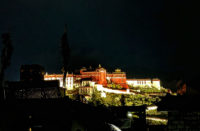
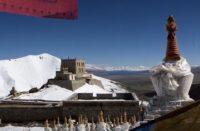
Follow Us!